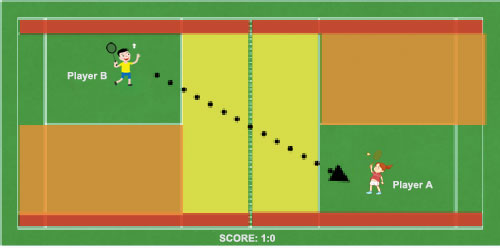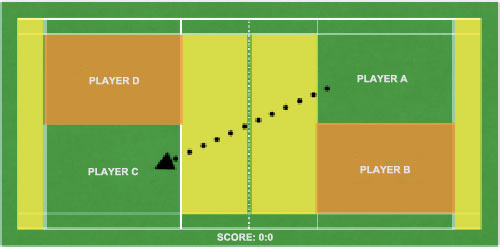Playing badminton can be great fun, but if you don’t know the rules, it can be frustrating. By learning the badminton rules and regulations, you will increase your understanding and enjoyment of the game.
The rules will vary, depending upon what type of game you play, whether single or doubles or tournament or casual match. Learning about the badminton rules and regulations will allow you to play better and enjoy the game more.
The rules of playing badminton seem quite complicated at first, with the variations between who will serve, the positioning on the court, and which areas of the court are considered in or out.
There are also variations to these rules depending on if you’re playing Singles (1 vs. 1) or Doubles (2 vs. 2) that make it more confusing, but the rules are critical to know so you can play competitively and improve your badminton skills.
The Basics
Whether you are playing Singles or Doubles, these basics apply:
- Things You’ll Need–before playing a game, make sure you have the following equipment:
- Badminton Racket
- Shuttlecock
- Rubber Shoes
- Light Clothing
- Water
- The Toss– this is done by hitting the shuttlecock upwards to decide which side serves first. Whichever side the shuttlecock points to when it lands will be the first to serve.
- Serving from the Left or Right Side–whenever the score is even (0,2,4,6,…), the server must serve from the right side of the court, and when the score is odd (1,3,5…), the server must serve from the left side of the court. This is why you’ll often see teammates switch positions on the court when the score changes.
- Serving to the opposite side–when serving, always serve diagonally to the opposite side.
- Faults–a rally continues as long as each team/ individual can hit the shuttle to go over the net to the side of the opponent within the boundaries of the court. If the shuttlecock does not go over the net or lands outside, this is considered a fault, and the point goes to the opposing team/player.
- Winner’s Ball–whoever won the last point will get to keep serving until the other team scores. Once a non-serving team scores, they get to serve.
Badminton Scoring Rules
The scoring system varies depending upon who is playing.
A badminton match consists of three games, and the person or team who scores best out of these three games wins.
The same rules of scoring apply for both singles and doubles:
- Each game is a race to 21 points.
- A team scores anytime the opposite team has a fault, regardless of who serves.
- Each time a team wins a rally, they earn one point.
- If the score is tied at 20-20, the first team to gain a 2-point lead (ex. 23-21) will win the game.
Badminton Singles Rules (1 vs.1)
To start the game, one player must toss the shuttlecock. The side points will be the first to serve. Both players will then stand on the right side of their respective courts.
When serving, the server must direct the shuttlecock diagonally to the side where their opponent is standing. If the shuttle lands in the opposite (orange) area, it is called the wrong court, and the other player scores a point.
The area where the shuttlecock can land is in the green portion below. If it falls in the yellow portion, it is called a short, and the other team scores a point. If the shuttlecock falls in the red section, it is called out, and the other team scores a point.
After the serve, the two players can make the ball land anywhere within the green portion of the court.
When the serving player (Player A) scores, he switches sides depending on what his/her score is. If even, Player A moves to the right side; if odd, Player A moves to the left. The opponent (Player B) must also be on the opposite side depending on where the serving player is.
When the non-serving player (Player B) scores, he/she gets to serve next. Player B will serve from the left (odd) or right (even) side of the court, depending on his/her score.
You and your opponent hit the shuttle back and forth until a fault is made or the shuttle hits the court. When you reach the score that fits your sex and type of game, the game is over, and you can play again.

Badminton Doubles Rules (2 vs. 2)
To start the game, one player must toss the shuttlecock. The side points will be the first to serve. The serving player (Player A) will then stand on the right side of their respective court.
When serving, the server (Player A) must direct the shuttlecock diagonally to the side where their opponent (Player C) is standing. If the ball lands in the opposite area, it is called the wrong court, and the other team scores a point. If Player D hits the shuttlecock, this is a fault as Player C should be the one to return the shuttle.
The area where the shuttlecock can land is in the green portion below. If it falls in the yellow portion, it is called a short near the net or long at the ends of the court, and the other team scores a point. If the shuttlecock orange section is called the wrong court, and the other team scores a point.

After the serve, the two players can make the ball land anywhere within the boundaries of the court.
When the serving player (Player A) scores, he switches sides with Player B, depending on what his/her score is. If even, Player A moves to the right side; if odd, Player A moves to the left. The opposing (non-serving) team stays in their place.’
When the non-serving player (Player C/D) scores, their team gets to serve next. The order of serving whenever the non-serving team gets the point goes to the player standing on the side of the court that is following their score (right side even, left side odd). So if the non-serving team were able to score, Player C would serve if the score was odd, while person D would serve if the score were even.
It is Important to Learn the Rule
Badminton rules and regulations are many, so it is important to learn as much as possible about the game. Whether you are playing it as a hobby or as a professional, you will find that the rules are an important facet of the game that you need to know to play it correctly and competitively.
Please don’t get bogged down in the badminton rules and regulations, but learn them through playing. This can make it fun to learn and fun to play the game.
